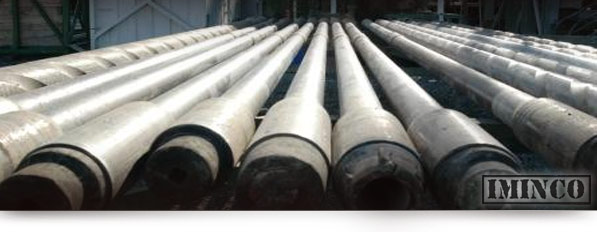
CSG stands for Coal Seam Gas. It is also referred to as coal bed methane.
It’s composition is mostly methane and is found trapped in coal underground coal deposits in natural fractures along the length and depth of the coal seam.
The releasing of the gas is typically achieved by removing the water from the coal seam, which released the pressure allowing the gas to be extracted to the surface.
Queensland Coal Seam Gas Bowen Basin
Queensland`s coal seam gas (CSG) industry has experienced massive growth over the past 15 years with the number of wells drilled increasing from 10 at the start of the 1990s to 600 at the end of 2011.
In the Queensland gas fields, a typical depth of the coal seam can be found around the 300m mark. Increasing growth is expected as more and more gas fields are discovered in the massive coal deposits in the Queensland Bowen (Permian coal measures) and Surat (Jurassic Walloon Coal Measures) Basins.
These two locations alone account for more than 79 per cent of the total gas produced in Queensland and provides 1000’s of jobs for local and interstate FIFO workers. In the Bowen Basin, gas production centres around locations near Moranbah, Injune, Moura and Wandoan.
Coal Seam Gas produced at Moranbah is sourced from the GoonyellaMiddle (GM) and P seams of the Moranbah Coal Measures. Future production looks positive at the Goonyella Middle Lower (GML).
At Moura, Coal Seam Gas is produced from the Permian Baralaba Coal Measures. Exploration and drilling is concentrated around the Moura area, at Theodore and at Baralaba. Exploration and development again is concentrated on coal seams that are about 300m in depth.East of Wandoan at Scotia and Peat, coal seam gas is sourced from the Baralaba Coal Measures.
The Peat and Scotia CSG fields are located on the Burunga Anticlines where gas is located around 700 to 800 m in depth.
Once the gas has been extracted from the coal seam, it is pumped to the surface and connected to a vast network of additional smaller pipelines that feed into the main pipeline. This primary pipeline runs 100’s of kilometres to the Gladstone gas processing plants on Curtis Island, off Gladstone.
Queensland Coal Seam Gas Surat Basin
Since 2000, the Surat Basin has yielded significant attention as a major source of CSG and potential was realised, owing to the abundant source of low-ranked coal deposits. These low-ranked coal deposits were know to produce large commercial quantities of gas, making the potential for the Surat Basin to become a major producer of CSG.
Commercial production has centred around the locations of Kogan North (west of Dalby), the Berwyndale South CSG area, south-west of Chinchilla. CSG is also currently produced from several areas ranging from Dalby to Chinchilla.
Coal seams in the Surat Basin were found to be not as deep as those in the Bowen Basin and generally consist of a lower gas content. Despite this, CSG has been commercialised using a wide range of well-completion techniques. The Surat Basin has been found to have more gas reserves than those in the Bowen Basin.
Queensland Coal Seam Gas Galilee Basin
The Queensland Galilee Basin extends north past Hughenden, south to Charleville and west beyond Winton to Middleton. It covers around 250,000 square kilometres and contains huge quantities of thermal coal. The coal seams are close to the surface in the north-east of the basin where proposed open-cut and underground mining operations are likely.
The coal deposits are thought to be similar to that of the Bowen Basin. Further drilling an exploration is currently being undertaken. The development of the existing coal deposits is still in its infancy and CSG extraction is still a proposal for this area.
Note: The average-sized Queensland coal mine produces about 5 million tonnes (Mt) of coal per year. The Galilee Basin (proposed) Alpha Coal project would produce 30 million tonnes of coal per year.
However, there is another mining project that could produce around 60 Mt of coal every year, for up to 150 years – this is Adani`s Carmichael mine. Altogether, if all the current proposed mines in the Galilee Basin go ahead, a total of more than 300 Mt of coal will be dug out of the area every year, increasing Queensland`s coal production by around 150 per cent.
Queensland LNG
The Queensland Curtis Island LNG project is on track to be the first in the world to convert natural gas from coal seam into LNG. It is a massive undertaking involving around 6,000 wells in the Bowen Basin as well as the additional expansion of gas wells in the Surat Basin. To transport the gas to the LNG liquification processing plants on Curtis Island requires the construction of a 540km pipeline to Gladstone.
There are more plans to develop and process LNG for export. If all of the current projects and proposals are developed to full capacity, it would mean a potential LNG export market for the Queensland alone of more than 50 million tonnes per year.
Current infrastructure consists of a staggering 4000 kilometres of gas transmission pipelines. More pipelines are planned or are currently under construction (which create more gas pipeline jobs) to supply gas to the Gladstone LNG plant as well as to other states in Australia.
LNG projects in Australia
- Australia Pacific LNG (APLNG)
- Gladstone Liquefied Natural Gas (GLNG)
- Queensland Curtis LNG Project
- Arrow LNG Project
What is CSG going to do for Queensland’s economy
CSG exploration is expected to boost Queensland`s economy by A$32billion. As a country, Australia has CSG reserves in Australia were 35 905 PJ (33 tcf). This equals a reserve life of about 150 years at current rates of production. However, production is projected to increase with the rapid growth and development of the CSG LNG industry.
Queensland has about 92% of the total reserves (33 001 PJ). Nearly all current reserves are contained in the Surat (69 per cent) and Bowen (23 per cent) basins wit small amounts in the Clarence-Moreton (1 per cent) Gunnedah (4 per cent), Gloucester and Sydney basins
The CSG industry is being billed as a “once in a generation opportunity for a generation of Queenslanders looking for employment in the gas industry”. It is estimated that the industry could offer as many as 18,000 direct and indirect jobs in gas in Queensland.
What is CGS : Jobs in CSG
The CSG/LNG industry offers a wide range of employment opportunities in:
- Drilling and explorations at coal seam gas fields.
- Pipeline construction, compression stations and related infrastructure.
- Building LNG processing plant facilities and infrastructure.
- Pipeline operations and maintenance, compression stations and infrastructure.
- Management, operations and maintenance of LNG processing plant facilities.
Some of the jobs you can do in the CSG/LNG industry incllude:
- Driller and driller’s assistant
- Electrical and instrumentation technician
- Electrical fitter mechanic
- Engineer – most disciplines
- Logistics technician / administrator
- Production technician
- Maintenance technician
- Process plant operator
- Geologist
- Geophysicist
Gas Facts
- Liquefied Natural Gas (LNG) is primarily composed of the lightest hydrocarbons, methane (CH4) and ethane (C2H6)
- Gas is Australia`s third largest energy resource after coal and uranium. This is unlikely to change in the period leading up to 2035.
- In the outlook to 2035, CSG is expected to remain the most important sector of the unconventional gas industry.
- Australian gas production is projected to increase substantially overthe period to 2034″�35.
- Australia accounted for around 2 per cent of world gas reserves and 2.1 per cent of world production in 2010.
- Australia is the world`s fourth largest LNG exporter and accounted for 9 per cent of worldLNG trade in 2010.
- Large coal seam gas (CSG) resources exist in the coal basins of Queensland.
- Australian gas consumption has grown by 4 per cent per year over the past decade.
- LNG exports are expected to account for around 68 per cent of Australian gas production in 2034″�35
- The main gas users in Australia are the manufacturing (32 per cent), electricity generation (29 per cent), mining (23 per cent) and residential (10 per cent) sectors.
- Around 48 per cent (18 Mt, 972 PJ, 0.9 tcf,) of Australian gas production was exported as LNG in 2009″�10.
- Gas consumption in Australia is projected to increase by2.9 per cent per year to reach 2611.
- CSG LNG will provide an important contribution to the growth of the exports to Asia.
Reference: What is CSG? | A detailed reviews of Coals Seam Gas projects in Queensland. An overview of the Australian gas sector.


